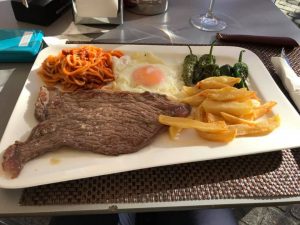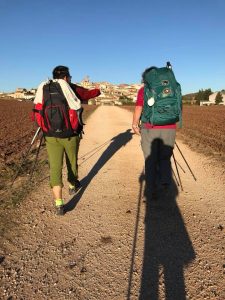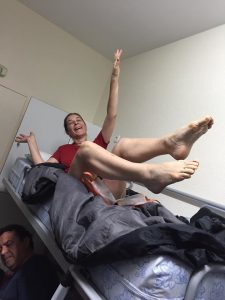If you are thinking about walking the Camino De Santiago then this may be the blog for you. As a soon to be Pilgrim, there are many questions that I am often asked, so I thought that a blog may be the ideal place to answer them. Here are the twelve most frequent questions that I get quizzed about..
1. Do I have to know Spanish to walk the Camino?
No, but it does help if you know a little bit of Spanish. There are apps such as Duo Lingo and Memorise which I found incredibly useful, but most people will get by with knowing little or no Spanish whatsoever. Over the last 12 months, I found that Google Translate is used more and more, so please make sure that you have downloaded this application to your phone if you do not speak fluent Spanish. You never know when you will need it in an emergency.
2. Do I have to carry my backpack all the way to Santiago?

However, I must inform you that some Albergues or hostels will not allow you to stay overnight if you have not carried your own pack, so this is something that you need to be aware of. Often you will see signs on the hostel doors saying that only those pilgrims who have carried their own rucksack will be allowed to stay.
3. What do you eat on the Camino?

The weirdest meal. Look at the spag bol in the top left corner
This will be different for everyone, however, the majority of people usually indulge in the delights of a Pilgrim Menu. This is a hearty meal for around €10-€12 that comprises of:
- A starter such as salad, spag bol, or soup (which is often so filling that you can hardly eat anything else!)
- A Main meal which will be something with meat, fish or chicken (usually accompanied with chips)
- A dessert such as a flan (or we Brits know it as cream caramel, but a sloppy version without the hard crust) or a yoghurt.
- Most meals come with a full bottle of wine and bread. Bread is issued with everything!
It is worth noting that you will often be served Santiago Cake (an almond-based sponge cake), or a little dish of nuts, crisps or snack when you order a coffee or hot tea.
There are many restaurants available on most Camino trails, so if the pilgrim menu is not to your taste then you can certainly have options in most towns and larger villages.
Another very popular way of eating on the trail is to cook yourself. Most hostels will have a self-catering kitchen with utensils, and there is something magical about a group of people cooking and eating together, sharing the responsibility. If you have specific dietary needs, or perhaps you are a vegetarian, then this option of buying your own meal at the local supermarket will enhance your Camino experience (Some areas of Spain have not yet caught up with the vegetarian lifestyle)
4. How much training do you have to do/how fit do you have to be to walk the Camino?

Jaume & Lou
That is a tough one to answer as I don’t think any amount of training can prepare you for walking day after day through terrain that you simply can’t replicate at home. Saying that I do believe that you should try to get as much walking (including hills) as physically possible, and to see if you can walk 10 miles at least two days on the hop (more if time will allow). No matter what, you should ALWAYS make sure that you have comfortable shoes and they are broken in before you set foot on the Camino.
For those of you who are interested, I have put together a training plan which you can see here.
5. Can I walk the Camino alone as a woman, or should I find friends to walk with?
Hey, I’m a woman and I have completed two solo hikes on the Camino, so yes, go for it! You will never be alone on the Camino Frances or the Camino Ingles Routes. There will usually be someone behind you and you should be able to spot a familiar shell dangling off a backpack in front of you. Many people walk the Camino on their own and this is something that I would encourage anyone to do. The Camino is a safe place to walk, and there are now Camino police who patrol the trail to make sure that everyone is ok.
6. What size pack should I bring?
Please try to refrain from borrowing a rucksack from a friend, unless that friend is of a similar build to yourself. The size of the pack should ideally be no smaller than a 30L and no larger than a 50L. In all honesty, the fit of the pack is more important than the literage. I would recommend taking a trip to your local outfitters (such as Cotswold Outdoors, Mountain Warehouse or Go Outdoors) and ask for their advice. They will try you with numerous backs and tell you the pros and cons of each. They also have weights which they will load into the pack to give you an idea of how it will feel fully loaded.
Both Rachel and I purchased Osprey packs (Atmos brand), and we had them fitted at Cotswold Outdoors. Buying the correct pack that is right for you is probably one of the most important decisions that you will make about gear on the Camino.
As a side note, please make sure that you have walked at least 10 miles with a fully loaded pack on your back at least 4 times before setting foot on the trail. It is amazing how much difference a full pack can make on your walk.
7. Should I bring a roll mat, just in case there is no room at the inn?

There is always a bed to be found somewhere!
No. There is a myth that the beds are taken quickly on the Camino and that you may find yourself sleeping on the floor. This may be true if you are walking out of season (November – February) and perhaps walking the Norte or Portugal Routes, but I have always managed to secure a bed during all of my five Camino’s. Yes, the beds in the main hostels, known as municipals, may be taken up early, but if you are prepared to pay a little bit extra then there are always other hostels, bed and breakfasts or hotels available. Private hostels in Spain are known as Pensions.
8. What about bedbugs?
I have known a few people who have had bed bugs but it is not as common as you may think. Bed bugs are more active during the summer months on the Camino (June to September). I have never had a bed bug bite in all of my Camino’s but I have a little routine that I go through that decreases my chances of being bitten.
- I sleep in a silk sleep sheet that has been sprayed with a repellent.
- I always check the area before selecting a bed (main places to look are behind a headboard and where a mattress is against a wall).
- Never put your rucksack on the bed as this is the easiest way to transport bed bugs from one hostel to another.
- There are some great tips about bed bugs (along with links to bed bug sheets and repellents here).
9. What’s the weather like in _______ month?
This is always a difficult one to answer as the weather in Spain varies depending on the season. In general:-
- Jan – March, it will be cold! Sleeping bags are a must and expect snow!
- April – June, it will be similar to a British spring with warm days (often very warm at times!). You may want to take a sleeping bag and warmer clothing for April and perhaps May as the evenings can get chilly and you are not always guaranteed a blanket from the Albergue.
- June – September, hot! Although it can still be a little chilly at night, during the day you will certainly need sunscreen protection, and there is no need to take a sleeping bag.
- October – January, early October you will still experience warm days, but come late October through to January you can expect cold nights and snow.
- Remember – it rains in Spain! A lot! Especially in the Pyrenees and Galacia regions which is why they are so green and beautiful. Rain gear is essential on all Camino trips.
10. How much does the Camino cost?
The Camino can be as cheap or as expensive as you want it to be. If you prefer to stay in private hostels, have your baggage shipped and eat in nice restaurants every day then you can expect to pay approx €100-€150 a day. On the other hand, if you are staying in a municipal, cooking your own food and carrying your own pack, then you can expect to pay around €15-20 a day. I personally budget for around €35 a day, which covers everything that I would need.
11. How do I choose which route to do?
There are many different routes to take to Santiago and it really depends on what you would like to get out of your trip. In summary:
- Camino Frances is the most popular route and has the best infrastructure. This route is 890km (500 miles) and starts in St Jean Pied De Port. If this is your first Camino then I would recommend starting here as it has the best support network.
- Camino Norte & the Portugal Routes – are much quieter routes. Both cover coastal walks which is stunning, but you may go for a few days without seeing a soul. If you are looking for solitude, then either of these routes will be great to walk.
- Camino Ingles – this is a short Camino which you can complete and get your Compostela in just 4 days. 68 miles / 112km. It starts on the coast and works its way inland towards Santiago. It is easy to get to the start and the infrastructure is excellent. There are not as many municipals on this route, but there are plenty of hostels and bed and breakfasts. There are plenty of people walking this journey, but it is not as popular as the Frances route.
12. Can you still get your certificate if you have walked the route in sections?
Yes. As long as you have secured at least two stamps every day in your Camino passport and walked over 100km (even if that is over many different trips) then you can claim your Compestella.
Summary
The above are the most popular questions that I am asked about the Camino, however, I am sure that there are many other questions that some of you may have. Please feel free to comment below and I will respond accordingly.
Thank you for reading this blog.

